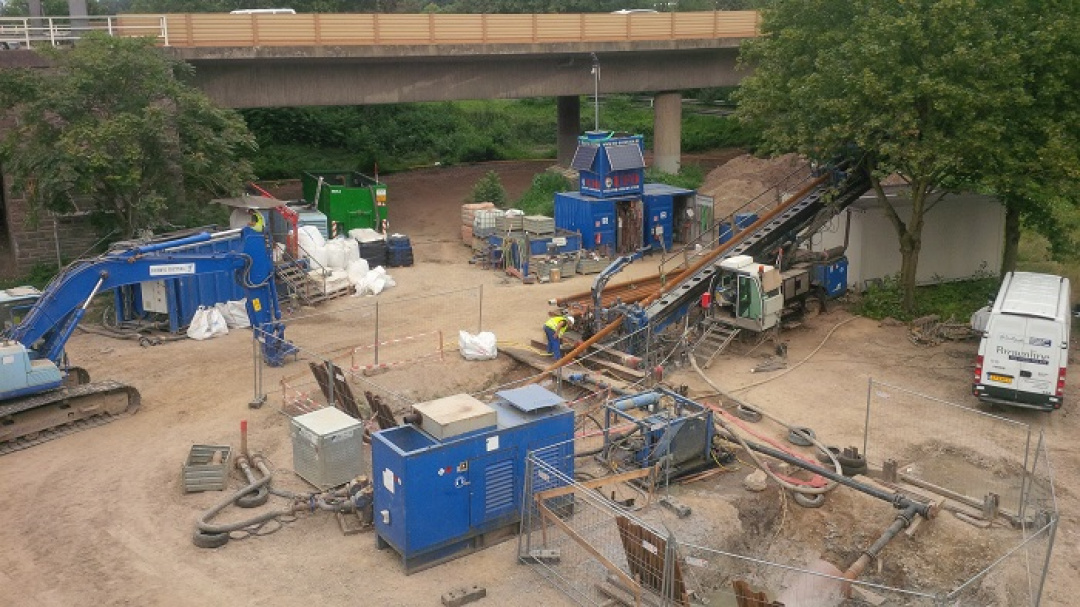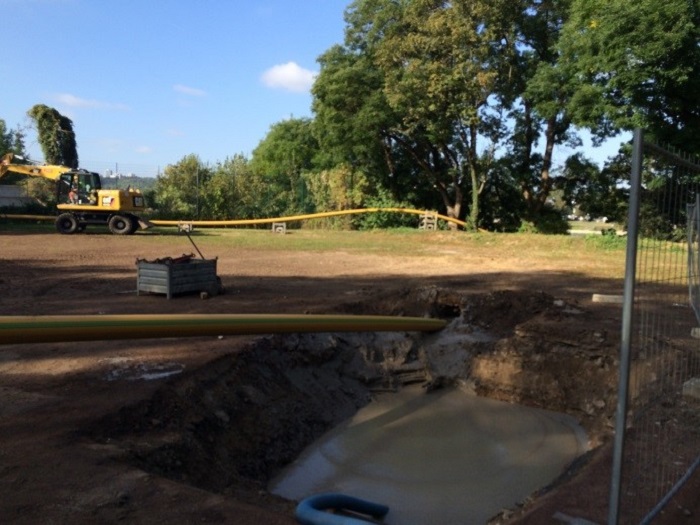New Culverts for Koblenz
Last century, three pipelines were installed on the large bridges in the city of Koblenz, Germany, to supply the city to the east of the Rhine with gas and water. The planned demolition of one of the bridges and the need for restoration of the pipelines now required replacement of these pipelines to maintain supply to this area.

 14.03.2017
14.03.2017
Last century, three pipelines were installed on the large bridges in the city of Koblenz, Germany, to supply the city to the east of the Rhine with gas and water. The planned demolition of one of the bridges and the need for restoration of the pipelines now required replacement of these pipelines to maintain supply to this area.
 Figure 02: Location of the culverts under the Rhine (Source Google Earth)
Figure 02: Location of the culverts under the Rhine (Source Google Earth)
Three crossings, two in Koblenz Oberwerth (420 m each) and one in Koblenz Pfaffendorf (395 m) were ordered. Two PEHD pipes OD355 mm for gas and water were planned for Oberwerth and one PEHD pipe OD225 mm would be used for gas transport in Pfaffendorf. Due to the restricted urban location the drill profiles, especially the radii, had very little margin for error and could not be adapted during drilling in case of steering problems. In addition to the usual HDD works, casing pipes at the entry points had to also be installed. This was required due to both the geological conditions and the requirements of railroad authorities, as the drillings in Oberwerth had to cross the railway running alongside the Rhine. The aim was to stabilize the non-drillable, gravelly areas down to the underlying mudstone and thereby the protection of the tracks. Further gravel layers at the exit points had been improved with the method of high pressure cement injections by the Client.
Oberwerth
After the project planning phase and preparation of the sites, the casing installation works began at the beginning of July 2016 above the right bank of the Rhine. 800 mm steel pipes were pushed into the ground without a rock drilling tool running in front of the casing but on reaching the rock layer, it was not possible to continue the casing installation into the mudstone and to completely cross the railway area. Surveys of the tracks showed no movement which appeased those undertaking settlement monitoring at that time but, nevertheless, a solution had to be found to prevent possible future settlement of the tracks. After approval of the railway company, the Client decided to carry out a cementation proposed by LMR to stabilize the gravel section and the installation of a sleeve pipe over product pipe. A second 800 mm casing pipe was installed for the following crossing using the same method.
At the beginning of August, after the preliminary work had been completed, LMR mobilised the drilling equipment to Koblenz and began to set up the drill site. Starting with a 10⅝" roller bit, mud motor and gyro steering system, the pilot drilling was well aligned with the ground improvement zone approaching the exit area, but as the bit entered the improved ground, the mud returns stopped, the torque increased and the drill string jammed in the borehole. With a lot of skill and experience, the string was worked out and pulled out for inspection. The decision was made to drill the last 40 m with a smaller bit and the pilot hole was completed successfully but partly with total mud losses and rather poor drilling progress as the gravel caused the forces on the string to rise.
After completion of the pilot bore for the gas line, the drill string remained in the bore hole, the rig was moved to the second crossing and the drilling for the water pipe started. The pilot drilling operations were similar to the first, without any incidents, until the soil improvement was reached where once again the return flow stopped and the string started jamming. This time, the drill string had to be dug out and was pushed the last 20 m above ground to the exit point. During these earthworks it was noticed that while the cement injection had stabilised the gravel in some spots, it had not penetrated the whole area. It was this that had led to the jamming of the drill string.
Afterwards, a 20" hole opener was used to expand the borehole to its final diameter. The drill string of the first pilot hole could fulfil its purpose as a return line, as planned, since no mud losses occur during the reaming operations. In parallel with the reaming of the borehole, LMR pulled the pipe line in a 90° bend through a forested section of land behind the exit point and prepared it for pull back. On September 2nd the water line was pulled into the expanded bore hole within four hours. The installation of the sleeve pipe and grouting of the annuluses in the railroad area were carried out right after pull back.
The drill rig was now returned to the crossing for the gas line and the bore hole was reamed to the final diameter. The reaming process once again progressed smoothly and the pipeline was successfully pulled in on September 12th. Installation of the sleeve pipe and grouting of the annuluses were done, before the drilling equipment was transported downstream to the Pfaffendorf site.

Figure 03: PEHD-Pipe ready for pull back
Pfaffendorf
The crossing in Pfaffendorf began in mid-August with the setting up of the construction site on the Rhine’s left bank near the city centre of Koblenz. Afterwards, the casing pipe was installed to stabilize the gravel layers. Unlike in Oberwerth, a 600 mm casing was installed, but once again the same pressing method was used. As had been the case in Oberwerth, the casing installation started well but shortly before reaching the mud stone, the soil above the casing (and on the shoreline of the Rhine) collapsed. The resulting damage was repaired in a quick and uncomplicated way by the Client and the casing installation could be finished to the rock layer. For this crossing, the end of the casing was to be cemented in position after the drilling equipment has been installed using the HDD rig.
After the construction site in Pfaffendorf had been set up by LMR and the steel pipe was sealed with cement suspension, the drilling works began. For this pilot hole a 12¼" roller bit, a mud motor and the gyro steering system were chosen. The bit size was sufficient to install the OD225 mm gas line without a further reaming step. Up to the soil improvement at the exit side, the pilot drilling proceeded as expected. As before, total losses in the area of the soil improvement occurred and the string nearly stuck. With frequent cleaning of the bore hole, the pilot hole could finally be completed and product pipe installation started the next day.
The pipe was laid along the right bank of the river Rhine and guided in a 270° loop to the exit point. This was necessary because the limited space did not allow a different approach. The rather complex pipe layout led to a much slower pull back operation than usual. However, after eight hours the pipe installation was finally successfully completed.


Figure 04: Pipe Layout Pfaffendorf
Conclusion
The crossings in Koblenz were characterized by the urban conditions, which are rather unusual in maxi drilling projects, but which could be well prepared prior to the construction phase in a detailed planning. The occurrence of the geological difficulties at the exit sides and during the installation of casing pipes could not be foreseen and required some unplanned adaptations of the operations and techniques. Here it has to be mentioned, that the excellent communication and cooperation of all project participants finally led to the success.
all news